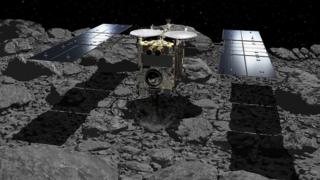 Image copyright
Image copyright
Akihiro Ikeshita
Artwork: Scientists want to retrieve a pristine sample of material from the crater
The Japanese Hayabusa-2 spacecraft is about to detonate an explosive charge on the asteroid it is exploring.
The operation is designed to generate an artificial crater in the asteroid Ryugu, which the probe has been studying since June 2018.
Hayabusa-2 will later descend into the crater to collect pristine samples of the asteroid that have not been exposed to the harsh environment of space.
The charge is carried on the Small Carry-On Impactor (SCI) device.
This is a 14kg conical container attached to Hayabusa-2 and packed with plastic explosive.
- Movie shows moment of asteroid landing
- Asteroid mission exploring a ‘rubble pile’
- Metal world ‘may have iron volcanoes’
The SCI is due to separate from Hayabusa-2 at 01:56 GMT on Friday at an altitude of 500m above the surface of Ryugu. That will kick off a 40-minute countdown to detonation. When the device explodes, it is expected to punch a 10m-wide hole in the asteroid.
In the meantime, Hayabusa-2 should have manoeuvred itself to hide away on the other side of the asteroid, shielding the spacecraft from any flying debris.
On the way, the Japanese Aerospace Exploration Agency (Jaxa) probe will deploy a small camera, called DCAM3. The camera will observe the explosion from a distance of about 1km and transmit images back to its “mothership”.
Yuichi Tsuda, the mission’s project manager, explained: “We expect the impact accuracy [of the SCI] to be something like a 200m radius, it’s very large… we expect to have a hole somewhere in that very big region.
“We will try to find that artificial crater two weeks later, by descending to a lower altitude and making extensive observations.”
A video of the SCI being tested on Earth can be seen below:
Ryugu belongs to a particularly primitive type of space rock known as a C-type asteroid. It’s a relic left over from the early days of our Solar System.
But bombardment with cosmic radiation over the aeons is thought to alter the surfaces of these planetary building blocks. So, scientists want to get at a fresh sample that hasn’t been changed by this process.
Speaking at last month’s 50th Lunar and Planetary Science Conference (LPSC), project scientist Sei-ichiro Watanabe said the experiment would also “provide us with information of the strength of the surface layer of Ryugu”.
This could help shed light on how the asteroid developed its characteristic “spinning top” shape.
Image copyright
JAXA, Uni Tokyo & collaborators
Ryugu has a characteristic “spinning top” shape
Scientific results suggest Ryugu was formed from loose debris that was blasted off a bigger asteroid and which then came back together to form a secondary object.
At the LPSC meeting, held in The Woodlands in Texas, Yuichi Tsuda told me how the team decided where on Ryugu to generate the artificial crater.
“There are two things: the first priority is to make a hole where we can easily identify a crater… so, easy observation, not too hard, not too bumpy,” he said.
“Second, somewhere that’s as feasible as possible in terms of landing… if those two don’t meet together, we go with the first priority.”
Scientists may command Hayabusa-2 to descend into the crater at a later date to collect a pristine sample of rock. But they will only do so if there is no risk of the spacecraft colliding with a boulder.
Follow Paul on Twitter.
Hayabusa-2: Japanese probe set to ‘bomb’ an asteroid}

